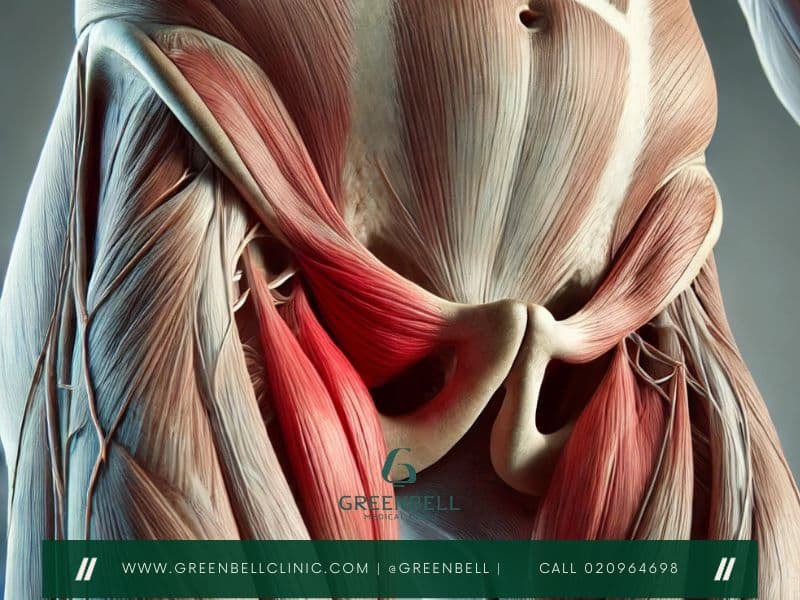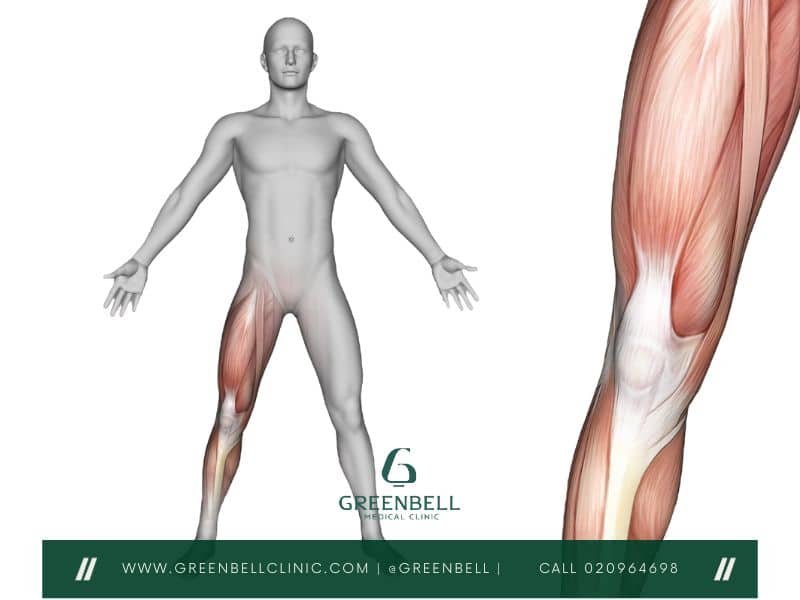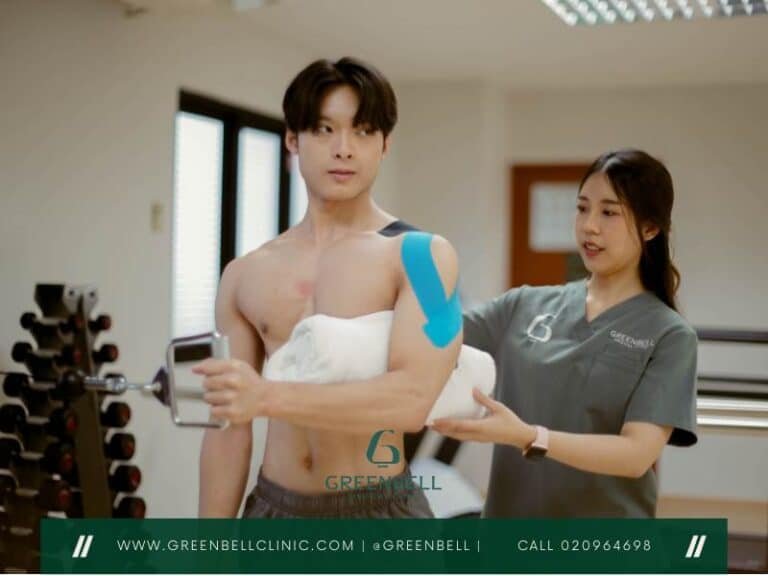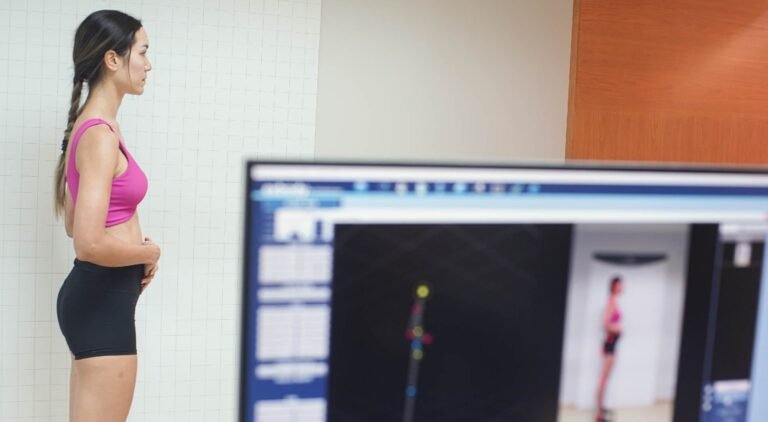Groin injuries can be really tough for anyone who’s active. Whether you’re into sports or just like to stay active, knowing about groin strains is key. This guide will help you understand groin strains better, so you can recover and stay safe.
This guide dives deep into groin strain anatomy. You’ll learn about the adductor muscles and how they affect hip movement and sports performance. This knowledge will help you understand groin strain treatment better.
If you’re dealing with groin pain or want to avoid it, this guide has lots of useful info. You’ll learn about common causes, risk factors, and types of groin strains. This will help you make smart choices for your health.

Groin Strain
Groin strain is an injury to the muscle-tendon unit that can cause discomfort when you touch the adductor tendons or their attachment to the pubic bone, as well as discomfort in the adductor area when resistance testing is performed on the adductors. It’s important to note that groin muscle strains are seen more often in sports like Football, Batminton, Basketball, which shows how active you are in these exciting sports!
These sports demand a powerful eccentric contraction of the adductor muscles during both practice and competition, which shows how strong and capable your body is. The underlying injury usually involves a muscle or tendon strain at the point where the adductor muscle’s tendon attaches to the bone, and it’s great to know that you can work on strengthening this area. The adductor longus is the muscle that is most frequently affected, which emphasizes the importance of taking care of this muscle group.
The distinction between groin tendinopathy and strain is very important to understand:
First of all, strains are typically acute injuries while tendinosis tends to be more chronic in nature. It’s helpful to recognize that tendinosis results from repetitive strain, so being aware of your movements can aid in prevention. The second difference is that acute injuries are usually more localized at the myotendon junctions, whereas chronic injuries tend to occur at the tendinous insertions on the pubic bone, highlighting the need for awareness in your training.
Key Takeaways
- Comprehensive understanding of groin strain anatomy and characteristics
- Exploration of common causes and risk factors for groin injuries
- Detailed overview of different types and grades of groin strains
- Insights into the impact of groin strains on daily activities and athletic performance
- Guidance on immediate care, pain management, and when to seek medical attention
What is a Groin Strain: Basic Understanding
A groin strain happens when the muscles in the inner thigh get too stretched or partially torn. These muscles help move and stabilize the hip and thigh. So, they can easily get strained during sports or other physical activities.
Common Causes and Risk Factors
Groin strains often come from sudden, fast movements like sprinting or jumping. Things that make you more likely to get a groin strain include:
- Not warming up or stretching enough before starting to be active
- Having muscle imbalances in the leg
- Having had a groin injury before
- Playing sports that need a lot of side-to-side movement, like soccer or tennis
Types and Grades of Groin Strains
Groin strains can be mild or severe, from just a stretch to a full tear. The severity affects how long it takes to heal and when you can go back to your usual activities.
The primary symptom of a groin strain is severe pain in the groin region. Muscle strain injuries typically occur due to excessive stretching or stretching while the muscle is actively engaged. Strain-related damage is often localized near the muscle-tendon junction. In acute injuries to the adductor longus, tendinous rupture or avulsion may occur, predominantly at the proximal insertion sites.
Clinically, an adductor strain presents with pain in the inner thigh, accompanied by tenderness along the muscle belly, tendon, or insertion point. Pain is notably aggravated by adduction movements. Tears commonly occur at the myotendinous junction, which is the weakest part of the muscle-tendon unit, though they may also be seen in the muscle belly. In adolescents, the same injury mechanism causing a muscle tear in adults may result in an apophyseal avulsion. Muscle tears are classified using a well-established clinical grading system, which includes three components.
Grade 1:
There is no loss of function or strength, which is a positive sign! Muscle tears may appear normal or show a small area of focal disruption (<5% of the muscle volume), and it’s encouraging to note that hematoma and perifascial fluid are relatively common on imaging with US and MRI, indicating that healing is being monitored effectively.
Grade 2:
While this injury is more severe and involves some weakness, it’s important to remember that it corresponds to a partial tear. Disruption of muscle fibers is observed (>5% of the muscle volume), but the whole muscle belly remains intact, which is a hopeful sign for recovery. During acute grade 1 or 2 strains of the adductor muscle, intense pain can happen in the groin area, similar to a sudden stab with a knife, especially if the athlete tries to continue activity; however, this is a natural response. Locally, a small amount of hemorrhage and swelling may be present a few days post-injury, which is a normal part of the healing process. A typical trauma history, localized tenderness, and some difficulties in contracting the hip abductors can be expected, but with proper care, improvement is on the horizon!
Grade 3:
This injury involves a complete muscle tear and a complete functional loss, which certainly sounds concerning. However, these injuries consist of complete muscle tears with frayed margins and bunching and/or retraction of the torn muscle fibers, highlighting the body’s response to stress. Complete muscle tears or grade 3 strains are most often found in the distal musculotendinous junction toward the insertion on the femur, but with the right treatment and support, a positive recovery journey can begin!
Groin Strain Anatomy Characteristic Treatment
Groin strains are common and affect the adductor muscles in the inner thigh. Knowing about these muscles is key to treating the injury. The adductor muscles help with hip and leg movement. When strained, they can cause a lot of pain and make daily tasks hard.
The usual treatment for groin strains is the RICE method. This stands for Rest, Ice, Compression, and Elevation. It helps with pain and swelling. Physical therapy is also used to help the muscles get stronger and more flexible again.

Physical therapists use different methods to treat groin strains. These include:
- Stretching and mobilization exercises to improve flexibility and reduce tension in the adductor muscles
- Strengthening exercises to gradually rebuild the muscle’s strength and stability
- Soft tissue massage to promote healing and reduce pain
- Modalities like ultrasound or electrical stimulation to facilitate the healing process
The treatment plan depends on how severe the strain is and the person’s goals for recovery. A physical therapist will assess the injury to create a treatment plan that fits. This ensures the treatment is effective and addresses the injury’s specific needs.
Understanding Adductor Muscle Group Function
Exploring groin strain anatomy leads us to the adductor muscles. These muscles are key for hip movement and sports performance. They are found on the inner thigh and help stabilize the hip joint.
Primary Adductor Muscles
The adductor muscle group includes the adductor longus, brevis, magnus, and gracilis. These muscles pull the thigh towards the body’s center. They also help rotate and flex the hip.
Biomechanics of Hip Movement
The adductor muscles are vital for hip movement. They work with the abductor muscles on the outer thigh. This teamwork is crucial for balance and stability in physical activities.
Role in Athletic Performance
For athletes, the adductor muscles are essential. They help generate power, change direction, and maintain stability. Adductor strains can greatly affect an athlete’s performance. It’s important to know about adductor muscles, groin strain anatomy, and treatment.
| Muscle | Function | Role in Athletic Performance |
|---|---|---|
| Adductor Longus | Primary hip adductor, aids in flexion and rotation | Crucial for explosive movements, direction changes, and stabilizing the hip during cutting and pivoting |
| Adductor Brevis | Assists in hip adduction, flexion, and internal rotation | Contributes to power generation and stability during sprinting and jumping |
| Adductor Magnus | Largest adductor muscle, responsible for adduction, flexion, and extension | Vital for maintaining balance and control during high-intensity activities |
| Gracilis | Assists in hip adduction and knee flexion | Helps with rapid changes of direction and sudden stops |
Understanding the adductor muscle group is key. It helps in treating and preventing groin strains. This knowledge is vital for athletes and active people.
Clinical Signs and Diagnostic Procedures
A thorough patient history and pain assessment by a physiotherapist are essential steps in diagnosing a groin strain. During evaluation, tenderness to palpation, focal swelling of the adductors, reduced adductor strength, and pain during resisted adduction are typically observed. Diagnosis can often be made based on these clinical findings without the need for imaging, following established classification guidelines.
Imaging, however, can be helpful in ruling out or confirming differential diagnoses when combined with a comprehensive clinical examination. Abnormal radiological findings, such as bone marrow edema around the pubic symphysis, are frequently observed in athletes with adductor or pubic-related pain. However, these findings are also common in asymptomatic individuals. Therefore, radiological results alone should not be relied upon for diagnosis, as structural changes do not always indicate a pathological condition.
Getting a groin strain right is key to fixing it. You’ll know you have one by feeling pain, swelling, and limited movement in your groin. It can hurt more when you do things like walk, run, or change direction.
Doctors use different diagnostic procedures to figure out how bad it is. Here’s what they might do:
- Physical exam: They’ll touch the groin area to check for pain and see how well you can move and lift.
- Imaging tests: X-rays, ultrasound, or MRI might be needed to see if there’s anything else wrong and how bad the strain is.
- Functional tests: You might have to do certain moves to show how much groin pain you have and how well you can move.
It’s very important to get a correct diagnosis. This helps doctors know exactly how to treat you. They can then make a plan that fits your needs to get you back to doing what you love.
Immediate Care and Pain Management Strategies
When you get a groin strain, acting fast is key for healing. Healthcare experts suggest a detailed plan to handle this injury. This plan helps manage pain and promotes recovery.
RICE Protocol Implementation
The RICE method – Rest, Ice, Compression, and Elevation – is a proven way to start treating a groin strain. It helps lessen pain, swelling, and injury risk.
- Rest: Stay away from activities that hurt the groin area. This lets the injured parts start healing.
- Ice: Use ice packs on the groin for 15-20 minutes, a few times a day. It shrinks blood vessels and cuts swelling.
- Compression: Use an elastic bandage or sleeve to support and limit movement in the groin.
- Elevation: Elevating the injured leg above your heart helps reduce swelling and improves blood flow.
Comprehensive Treatment Approaches at Greenbell Physical Therapy
At Greenbell Physical Therapy Clinic in Thailand, we manage groin strains and other injuries thoroughly. Our team of physical therapists and experts use many techniques. These help patients fully recover and avoid future injuries.
We also offer tecar therapy, a cutting-edge physiotherapy management method. It uses electrical currents to boost the body’s healing. This therapy reduces pain, improves blood flow, and speeds up tissue repair.

Our treatment plans include more than just tecar therapy. They also include:
- Personalized manual therapy to fix muscle and joint issues :
(When treating muscle-tendon injuries, immobilization should be kept to a minimum to prevent adverse effects such as muscle atrophy and functional decline. Initial rest is recommended immediately after the injury but should only continue until a proper diagnosis is established.) - Custom exercise programs to strengthen and improve flexibility
- Gait and movement analysis to find and fix biomechanical problems
- Special rehabilitation plans for a safe return to activities
At Greenbell Physical Therapy, we know every groin strain is different. We create a treatment plan that fits each patient’s needs. With our help, patients regain strength, mobility, and confidence. They can safely return to their active lives.
Rehabilitation and Recovery Timeline
Getting better from a groin strain needs a good plan that includes exercises and a slow return to activities. The time it takes to get better can change based on how bad the injury is. But, sticking to a plan can help you recover well and keep it that way.
The primary aim of our treatment program for muscle-tendon injuries is to minimize the effects of immobilization, restore full range of motion, and rebuild muscle strength, endurance, and coordination. In the initial phase, crutches, local cold application, and anti-inflammatory medication are recommended. Early introduction of muscle exercises is often beneficial, but training should be conducted within pain limits, focusing on careful isometric contractions against resistance.
As the initial phase transitions, the application of heat can be helpful, particularly when initiating muscle training. Exercises should generally be performed within a pain-free range of motion, and any increase in pain after activity should be avoided.
During rehabilitation, mild pain during exercise is acceptable as long as it subsides immediately after the activity ends. Once full range of motion is achieved, the injured muscle and tendon can tolerate greater loads. At this stage, the focus of rehabilitation shifts to specific strength training exercises designed to enhance muscle recovery, build endurance, and maintain a full range of motion.
The final phase involves a gradual return to sports activities, which may take 3 to 6 months, depending on the severity of the injury and individual progress.
Progressive Exercise Programs
The first steps in getting better usually involve stretching exercises and strengthening exercises. These help make the area flexible and strong again. As you get better, the exercises will get harder to keep pushing your body to heal right.
- First, focus on easing pain, moving better, and gently working the adductor muscles.
- Next, add exercises that are more active and help with strength, balance, and coordination.
- Finally, do exercises that are specific to your sport to get ready to play again safely.
Return to Activity Guidelines
When you can go back to sports depends on how well you’re doing and how bad the injury was. It’s best to go slow and let someone watch you to avoid getting hurt again.
- You might start with light, easy activities in 2-4 weeks, depending on how you’re doing.
- Then, slowly make the activities harder and longer over time.
- Always talk to a physical therapist to make sure you’re going back to sports safely.
Monitoring Progress
It’s important to check in often to make sure you’re getting better. Your physical therapist will keep an eye on you, change the plan if needed, and support you all the way through.
“Patience and diligence are key during the rehabilitation process. Rushing back too soon can lead to re-injury and setbacks, so it’s important to follow the guidance of your healthcare team.”
Prevention Strategies and Long-term Management
Keeping your groin safe and healthy is key for athletes and anyone who’s active. Using the right warm-up, stretching, and strengthening can lower the chance of injury prevention. It also helps you heal faster.
Warm-up and Stretching Exercises
Start your workout with a dynamic warm-up that targets the adductor muscles. Stretching exercises like hip adductor stretches and standing groin stretches keep your groin flexible. They also help with movement.
Strengthening the Adductor Muscles
It’s important to do strengthening exercises for the adductor muscles regularly. Side-lying leg raises, resisted adduction, and monster walks are good for building strength. They make your hips and groin area more stable.
| Exercise | Description | Benefits |
|---|---|---|
| Side-Lying Leg Raises | Lie on your side with your legs straight. Slowly raise your top leg, then lower it back down. | Strengthens the adductor muscles and improves hip stability. |
| Resisted Adduction | Stand with a resistance band around your thighs. Squeeze your knees together against the resistance. | Targets the adductor muscles and enhances groin strength. |
| Monster Walks | Stand with a resistance band around your thighs. Take steps sideways, keeping your knees slightly bent. | Improves adductor activation and hip abduction strength. |
Adding these prevention strategies to your routine helps keep your muscles strong, flexible, and healthy. This reduces the risk of groin strain injuries. It also supports your long-term musculoskeletal health.
Conclusion
Understanding groin strain is key to managing this common injury. Knowing the muscles and biomechanics involved helps. This knowledge lets healthcare professionals create effective recovery plans.
Physical therapy plays a big role in treating groin strains. At Greenbell Physical Therapy, experts help patients from start to finish. They use proven methods and tailor plans to each person, helping them recover and prevent future injuries.
If you have a groin strain, getting professional help is crucial. Proper care and prevention strategies are essential. This way, you can get back to your activities, feeling strong and confident again.





